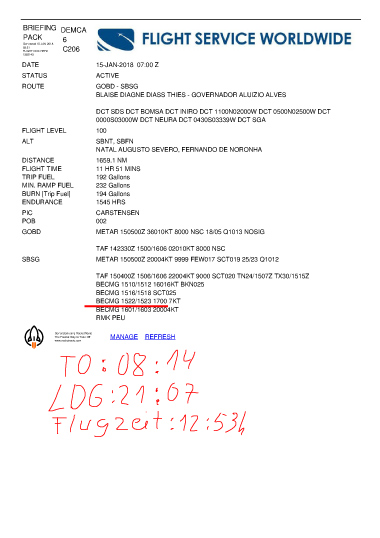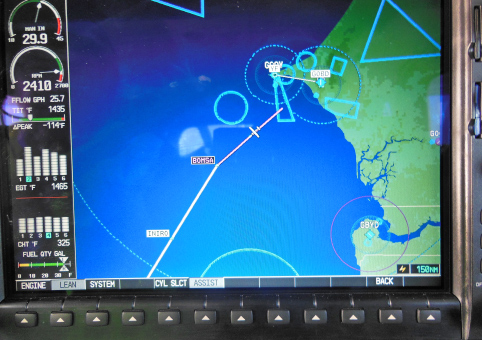Flight Log: Dakar GOBD -- Natal SBSG 15.01.2018/16.01.2018/17.01.2018


15 January 2018, Dakar — Natal:
The day started perfectly. Our driver came to pick us up at the hotel at 5 a.m. Unfortunately, 20 minutes into the drive I realised I’d left most of my credit cards in the hotel safe. So we had to turn round and go back. As a result, we realised we were facing a delay and wouldn’t realistically be able to take off at 7 a.m. as planned. But our handling agent and airport management were optimistic and didn’t think the delay was a serious problem. Another problem was that the airport’s computer system had crashed so that it wasn’t possible to pay the landing fees. However, the handling agent and airport officer were very pragmatic. We agreed that an invoice would be issued as soon as the computer system was up and running again, that we’d get the invoice by e-mail and pay it immediately. I was impressed with the solution. I could head for the plane at last, which Kurt had already got ready. We put our survival suits on, placed our cases on the very full extra tank and switched on the DEMCA. It started up straight away and communications with the tower were equally easy. As usual, we were asked if we had a high-frequency device on board. We said we had and were then given permission to take off. Marie taxied somewhat sluggishly — packed to bursting — just like a fat goose, over the airfield to runway 01. Two planes before us had to take off first before we could taxi onto the runway. Kurt was especially concerned whether the Cessna would be able to take off at all considering its load. But amazingly, 800 m later, at a speed of 75 knots and with the wing flaps at 10 degrees, Marie took off and ascended slowly but surely at about 70 m/min., or in other words 200 ft per minute. We were at full throttle for 40 minutes and then at flight level 100 at approx. 3,000 m. We wiped the beads of sweat off our foreheads and started to tackle the actual communication challenges because we had to phone Dakar Oceanic on our high-frequency device on frequency 6531 or 5565. I did manage to make contact and talk to Oceanic, even though I had to put up with ear-splitting background noise. In the meantime, Kurt continued to radio the tower on the VHF frequency. This was a case of the crew multitasking!
To be on the safe side, the tower had told us both the frequencies and the phone number, so that we would be able to reach Dakar Oceanic by satellite phone if all else failed. We also made use of this option and called them, so we had several ways of carrying out the flight properly. But it’s not true that the two pilots had an easy time of it during this period.
After a long flight in beautiful weather and tailwind of more than 10 to 15 kt, we saw the first layer of cloud about 100 NM before the Equator. This tallied with the weather reports we’d obtained beforehand. While we were crossing the Equator, we made a call via the satellite phone and talked to Marie (my wife) and we pilots wished Aniko a happy birthday. Making a call over the Equator was quite a thrill.
After a further two and a half hours, we actually saw land for the first time in the shape of Fernando de Naronje Island. This island has an airfield and was one of the places we could have made an emergency landing if our aviation fuel ran out. At this point, our extra 500-litre tank had been completely used, but the main tanks were still full. And now that we’d been in the air for almost 10 hours, it was time for some liquorice and a few pinches of salt to keep us — and particularly Kurt — going. By the way, one of this flight’s miracles was the fact that the longest flight came and went without either of us pilots having to heed a call of nature! This is a puzzle.
The approach to Natal was pretty unspectacular and we had friendly air traffic controllers, good communication and clear instructions. We were guided by radar to the airport’s runway 12. The controller who was guiding us asked several times what type of plane we had. We confirmed that it was a Cessna 206. Then he asked where we had come from. “We’ve flown from Dakar.” After a sigh of astonishment, he asked us a few more questions: “How far was that then?” “Yes, over 1,600 nautical miles.” “And how long did you take?” “Yes, we’ll have clocked up 13 hours.”
To which the controller replied: “Good grief, that’s incredible. Congratulations.” He continued to be very friendly and guided us to the tower so that we could land.
And that all happened during a fantastic Brazilian sunset. After landing, we had to carry out all the usual administrative tasks. The handling agent and his assistant were already waiting for us, plus several other teams whose roles we couldn’t really guess at. A short and stocky man approached Kurt and told him that arriving in Brazil without a book listing all inoculations was very strange and in particular if we were planning on travelling on to Argentina and Chile. He recommended we had the documents sent from Germany immediately.
We pretended we would and nodded. Then, in addition to securing the plane and doing all the customs formalities, we had to go through a special immigration ceremony. This is called Termo de Entrada e Admissão Temporária and means: Terms of Entry and Temporary admission. It involves the Brazilian authorities checking the reliability of the people entering the country as well as the plane’s technical condition and the pilots’ documents. The formalities involved a long questionnaire that both pilots had to sign at the end. But all that was soon completed. Finally, we had to work out which hotel to go to. I couldn’t find the hotel’s address on my iPad and tried to get hold of Marie in Germany. Poor Marie switched on her PC at 3 a.m. (note from the ground staff: Marie is always available). She sent me a WhatsApp, which however didn’t arrive, but told me on the phone which hotel it was. Kurt did a spot of interpreting so that the taxi driver was able to identify the place. So shortly before midnight local time, we were able to enjoy our landing beer and of course had a bit of jetlag because of the four-hour time distance.
So time to say goodnight.
 Loading. Please wait...
Loading. Please wait...













